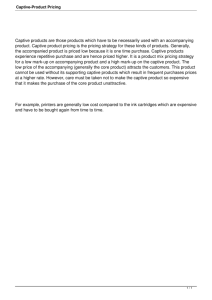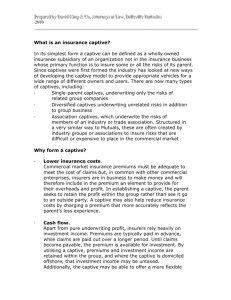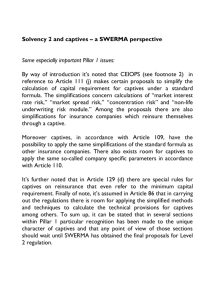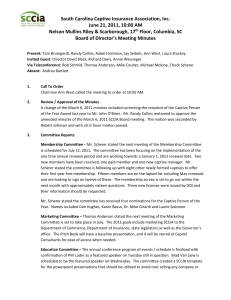How to Control a Group of Captives that is Not a Controlled Group
advertisement
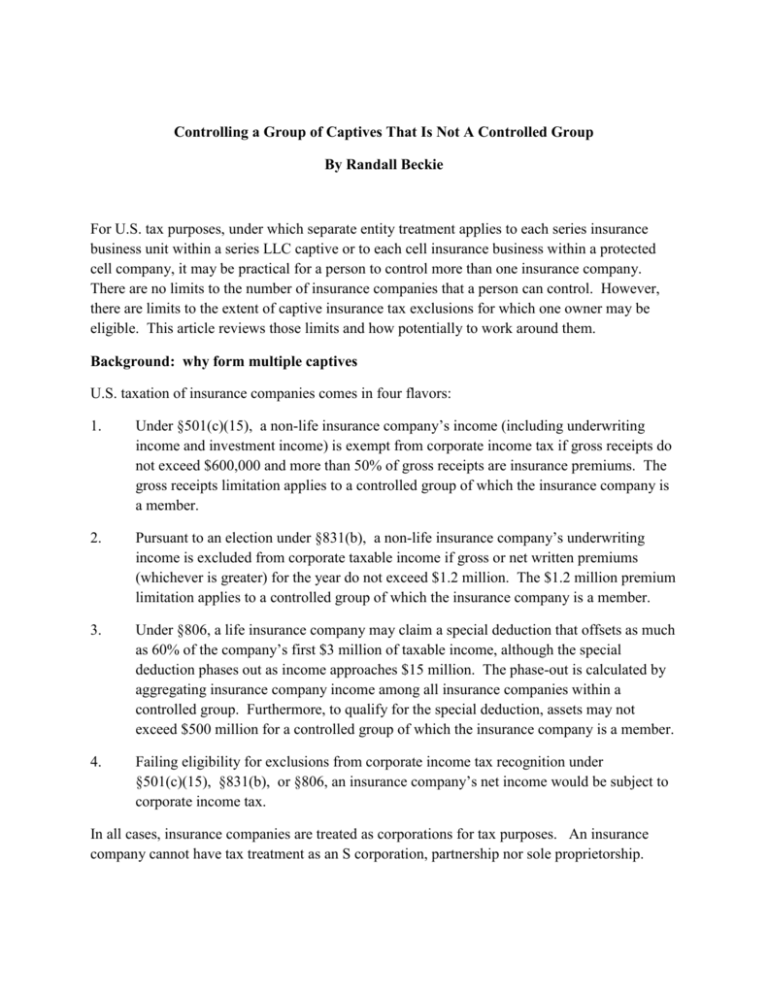
Controlling a Group of Captives That Is Not A Controlled Group By Randall Beckie For U.S. tax purposes, under which separate entity treatment applies to each series insurance business unit within a series LLC captive or to each cell insurance business within a protected cell company, it may be practical for a person to control more than one insurance company. There are no limits to the number of insurance companies that a person can control. However, there are limits to the extent of captive insurance tax exclusions for which one owner may be eligible. This article reviews those limits and how potentially to work around them. Background: why form multiple captives U.S. taxation of insurance companies comes in four flavors: 1. Under §501(c)(15), a non-life insurance company’s income (including underwriting income and investment income) is exempt from corporate income tax if gross receipts do not exceed $600,000 and more than 50% of gross receipts are insurance premiums. The gross receipts limitation applies to a controlled group of which the insurance company is a member. 2. Pursuant to an election under §831(b), a non-life insurance company’s underwriting income is excluded from corporate taxable income if gross or net written premiums (whichever is greater) for the year do not exceed $1.2 million. The $1.2 million premium limitation applies to a controlled group of which the insurance company is a member. 3. Under §806, a life insurance company may claim a special deduction that offsets as much as 60% of the company’s first $3 million of taxable income, although the special deduction phases out as income approaches $15 million. The phase-out is calculated by aggregating insurance company income among all insurance companies within a controlled group. Furthermore, to qualify for the special deduction, assets may not exceed $500 million for a controlled group of which the insurance company is a member. 4. Failing eligibility for exclusions from corporate income tax recognition under §501(c)(15), §831(b), or §806, an insurance company’s net income would be subject to corporate income tax. In all cases, insurance companies are treated as corporations for tax purposes. An insurance company cannot have tax treatment as an S corporation, partnership nor sole proprietorship. For closely-held business owners, captive insurance planning often involves qualifying for an exclusion under §501(c)(15), §831(b), or §806. One practical constraint is that the tax benefit of these exclusions is relatively small. For example, a captive with $500,000 in premiums and a 40% loss ratio would net $300,000 of underwriting income. Via §501(c)(15), the captive could avoid approximately $100,000 of corporate tax on $300,000 of income. It is not uncommon for a small captive to incur $100,000 in annual administrative costs from its service providers, although owners would be inclined to wind down captives whose G&A costs consistently outweigh the tax benefits. First, owners look for ways to increase tax benefits by increasing premiums. An increasingly popular solution involves enabling the closely-held business owner’s family to own multiple §501(c)(15) or §831(b) captives. This approach has become administratively feasible thanks to the series LLC captive regime in Delaware or under protected cell company statutes in other captive domiciles. In Delaware, for example, $250,000 of minimum capital that would be needed to form a traditional pure captive can instead capitalize a series LLC captive with multiple series business units. The aggregate administrative costs for the series business units could be just marginally more than for a traditional pure captive. In situations where the closely-held business could justify paying multi-million-dollar premiums to a captive insurance arrangement if only the arrangement could manage to exclude the underwriting income from corporate taxation, forming multiple captives may be appealing. This approach gained validation on September 14, 2010 when the U.S. Treasury Department published proposed regulations in line with Rev. Rul. 2008-8, regarding separate entity tax treatment of series captives and cell captives. Which brings us to confront the limits of possibility: namely, the controlled group aggregation rules. A single person owning two captives each with $600,000 of premiums (and no other income) could not qualify either captive under §501(c)(15), for each would exceed the $600,000 limitation on a controlled group basis. (In this example, each captive could qualify under §831(b) because controlled group premiums do not exceed $1.2 million.) Definition of a controlled group A brother-sister controlled group is defined to include C corporations more than 50% of which are owned by five or fewer persons, counting only their overlapping ownership percentages. Proposed Treasury regulation §1.1563-1(a)(1)(ii) would expand the definition of a controlled group to include S corporations. The preamble to the proposed regulation asserts that current law should be interpreted to mean that controlled groups include S corporations, although this position seems out of context with current Treasury regulations that specifically exclude S corporations from controlled groups. Some §501(c)(15 ) captives are under common ownership with S corporations. If the proposed regulations are adopted, the consequence would be to disqualify such a captive from §501(c)(15) because the S corporation’s gross receipts exceed $600,000. Constructive ownership attribution rules apply, such as: Ownership by one spouse is attributed to the other spouse. Ownership by a child under age 21 is attributed to the parent. Stock options count as stock ownership. Indirect ownership (beneficially through another entity) counts as ownership. On the other hand, the ownership attribution rules leave room for planning. Example: Father owns 100% of Captive A; Son aged 21 owns 100% of Captive B; Father and Son each own 50% of Captive C. None among Captives A, B or C are members of a controlled group, for no combination of captives is owned more than 50% by the same five or fewer owners (counting only their overlapping ownership percentages). The more adults in the family, the more 50/50 captives can be owned by two related adults. In essence, every adult can own 100% of one captive plus 50% of each additional captive that is coowned by a different adult family member. However, beware co-ownership of a captive by spouses, for ownership by one spouse is attributed to the other spouse even if direct ownership is 50% each. Also, if each spouse wants to own a captive separately, ownership will not be attributed from one spouse to the other spouse if the spouses stay out of each other’s business: e.g., husband must avoid being a director, employee or shareholder in wife’s captive and vice versa. If a family were to use all the leeway in the constructive ownership rules, the resulting arrangement might resemble a syndicate of cell captives all underwriting portions of the same risk pool. The tax issue becomes: What characteristics distinguish the cell captives from one another so that the IRS cannot recast them as a single unitary business? Under section 845 the IRS can recast reinsurance transactions where (among other justifications) the tax benefits are disproportional to the insurance risk. In a family-owned syndicate of cell captives, perhaps the cell captives would be prudent to operate as direct insurers rather than as reinsurers. It would fall on the captive manager to coordinate all this – literally controlling a group of cell captives so as not to be a controlled group, as defined for tax purposes.

